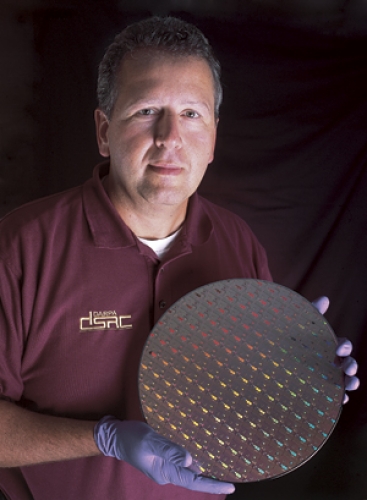Imagine a strand of hair split length-wise one hundred thousand times. Now, imagine the thickness of just one of the slices — a billionth of a meter. Yes, that’s an itsy-bitsy size. But think about that size in the same way scientists such as Joseph DeSimone think about it, and what you can get is big news.
Take DeSimone’s recent creation, for example, which could some day change the way we get medical treatment.
DeSimone, professor of chemistry and chemical engineering, and his research team have developed a way to create the world’s tiniest man-made particles that may one day be used to deliver drugs and genes into the human body. The tiny bits are less than two hundred nanometers in size. A nanometer is a billionth of a meter, or about one hundred thousandth the thickness of hair.
The researchers built the tiny particles through a process called Particle Replication in Non-wetting Templates (PRINT). By adapting technology used in the electronics industry to fabricate transistors, they used liquid Teflon to make molds that “look something like ice cube trays with tiny cavities in them,” DeSimone says. The end products are “ice cubes” that can be separated into individual particles, he says.
These particles are made out of organic materials, some from the same materials used to make bioabsorbable sutures, the fibers that stitch wounds in the human body and then dissolve in a few weeks. Traditional nanoparticles are made of metals or other inorganic materials, which must be baked, etched, or processed with solvents. Such treatments can destroy DNA and drugs. The nanoparticles developed by DeSimone’s team do not require such treatments, and can be biodegradable and bioabsorbable.
“Our method for the first time opens the door to marrying organic materials to nanotechnology,” DeSimone says. “Biology, after all, is almost exclusively organic materials.”
The technology also allows researchers to control the shape, size, and composition of materials when manufacturing the nanoparticles.
How does this affect you?
Because nanoparticles are so small, medical researchers may one day be able to better locate diseased cells and better target where to deliver drugs and DNA into the human body during chemotherapy and gene therapy, DeSimone says. The organic particles, which are currently being tested on mice, may also eventually allow medical researchers to take images of the body from the inside out.
And because the nanoparticles created by DeSimone can be molded into various shapes, including spheres, rods, cones, and trapezoids, these particles can be shaped like viruses. This would allow the particles to carry nucleic acids (useful in gene therapy) or act like a vaccine, he says.
“We really believe this work will have a profound positive impact down the road on human health care,” says DeSimone, who is developing and commercializing PRINT with colleagues and Carolina through Liquidia Technologies, the company he co-founded with doctoral students Jason Rolland and Ginger Denison. “This includes, but is not limited to, chemotherapy, gene therapy, disease detection, and drug delivery.”
Cherry Crayton was formerly a staff writer for Endeavors.
DeSimone’s PRINT research is supported by the National Science Foundation. His findings appear in the June 21, 2005, Journal of the American Chemical Society. Randy Mayes contributed to this story.


